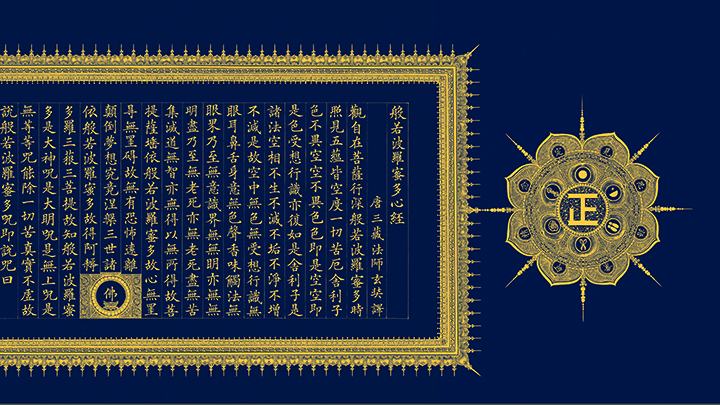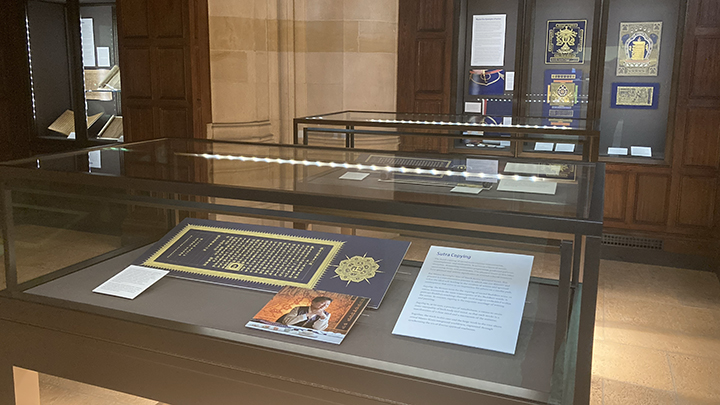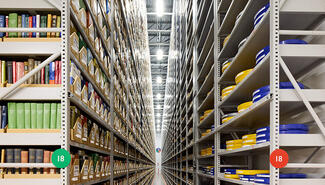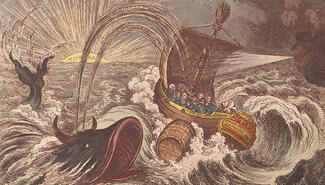New exhibit in Hanke Gallery features sacred texts across faith traditions
The new Hanke Gallery exhibit, “Copying Sacred Texts: A Spiritual Practice,” presents an array of handwritten and elaborately illuminated works—examples of the shared ancient practice of transcribing meaningful texts from various faith traditions.
At the center of this exhibit is the work of Kyeongho Kim, a living master of the art form.
Master Kim, who lives in South Korea, has dedicated 50 years to the practice of hand-copying Buddhist texts, or sutras. The Korean term for the traditional art of hand-copying sutras is sagyŏng, which exhibition curators Jude Yang and Hwansoo Kim describe as a “marriage of writing and painting.” In this nearly 2,000-year-old spiritual practice, Buddha’s teachings are conveyed through both the transcribed words of the sutras and through decorative imagery.
In Buddhism, as in other faith traditions, hand-copying is not only a means to preserve and share sacred texts but also a transformative experience for the practitioner. This exhibition is designed to encourage the hand-copying of texts—whether religious or not—as a meditative practice in modern times.
Universal practices
Although Master Kim is practicing an ancient craft, he innovates with contemporary ideas and elements to transcend traditional boundaries and make his work accessible to all. He incorporates elements from Christian, Jewish, Islamic, and Buddhist traditions in his intricate designs to illustrate the universal nature of spirituality.
The designs in two of the largest and most recent of Master Kim’s works—both titled “Dialogue between Traditional Sagyŏng, Bible Scriptures, Qur’an Scriptures, and Mandala”—reference the architecture of Islamic mosques and calligraphic scripts found in versions of the Qur’an, geometric Buddhist mandalas, and decorative drawings from the Book of Kells and Christian Bibles.
From as early as the first millennium BCE, biblical books were hand-copied by Jewish and Christian scribes. The copying of Jewish scriptures—the Torah—to prepare for ritual readings is still, generations later, considered a “work of heaven.” In their scriptoria (copying rooms), Christian monks hand-copied Bible texts as a profound meditation on the divine word. In the first millennium CE, master calligraphers launched a “golden age” of Arabic calligraphy. Islamic scribes developed a decorative, multiscript art form known as Quranic calligraphy specifically for copying verses from the Qur’an, elevating the act of transcription to an expression of faith and devotion.
To further illustrate the shared connections, several works from these various traditions—in original format and as facsimiles—are on display in the exhibit alongside Master Kim’s works.
Among the objects in the case “The Judaic Tradition,” is an artistic rendering of the entire text of the Biblical book “Song of Songs,” by the 18th-century scribe Barukh ben Shemariyah. This small work (11 x 9 in.) contains 2,661 Hebrew words. It is a remarkable example of micrography—a writing style in which tiny lettering is composed to form intricate designs.
In the adjacent case is the Albergati Bible, dated 1428. This version of the Christian text contains delicate, colorful illustrations and embellishments that were the work of at least four individual artists. That volume is paired with an earlier parchment manuscript, the Ruskin Bible, from the early 13th century, which was also handwritten and illuminated by multiple scribes.
The exhibit also features Islamic works, including a morocco leather–bound edition of the Qur’an, dating from 1813. The text is written in red, green, and black ink in naskhī script, a popular cursive and rounded style developed in the 10th century CE. A rare, illuminated Qur’an manuscript from China, written in Chinese-style Arabic calligraphy, dates from the 18th century. Recitation marks are added in red ink above the black lettering.
Korean sutra copying
As explained in the case “The East Asian Tradition,” monks traveling from India and Central Asia brought Buddhist teachings to Korean and Japan in the first century CE. The sacred texts they carried were translated into Chinese, hand-copied, and widely distributed.
These early scribes were committed to sharing key tenets of the faith and deepening their own understanding but also had further motivation.
The Lotus of the True Law Sutra, on view in a circa 14th-century version on paper, explicitly encourages Buddhists to copy the texts as a means of earning “merit”—a benefit also pursued by scribes in other faith traditions. The Infinite Life Sutra, for example, offers the believer and the scribe the promise of well-being for deceased and living family members. Because of its importance, this text, shown in this exhibit as a 19th-century woodblock print, has been hand-copied and printed continuously throughout East Asia since the 5th century.
The exhibition’s eight sections also include “Printing Practices.” In the 13th century, with the introduction of the printing press, Koreans began to mass-produce religious texts with movable woodblocks. They believed that wide dissemination of Buddha’s teachings would protect their country against invaders.
In 1251, Korean copyists working with the new technology and traditional rituals created the Tripitaka Koreana—81,258 woodblocks hand-carved with scriptures. In 1995, UNESCO designated this woodblock collection as a world treasure. A reprint of a print made with one of these woodblocks is on view, along with a reprint of the Buddhist text Chikchi. ha, one of the oldest surviving printed texts, which predates the printing of the Gutenberg Bible by 78 years.
The spread of printing slowed but did not entirely displace the practice of hand-copying. The practice endured in all faith traditions and is experiencing a revival today.
Extending the legacy
Described by the curators as a “true guardian of the sacred sutra-copying tradition,” Master Kim preserves and contemporizes this ancient tradition with his artwork. In 2020, the Korean government designated Kim as the sole Traditional Sutra Copying Skills Transmitter.
Master Kim is traveling from Korea for the opening reception of the exhibition on Tues., Feb. 27, from 4:30 to 7 p.m. in the lecture hall of Sterling Memorial Library. He will speak about his life and work and provide a demonstration of his meticulous technique of hand-copying sacred texts. Meghan Howard Masang—a scholar of Buddhist texts and a postdoctoral associate in the Council on East Asian Studies and the Department of Religious Studies—will present an introductory talk on sutra copying and Buddhism. Curators Jude Yang, librarian for Korean Studies, and Hwansoo Kim, associate professor of Korean Buddhism and Culture in the Department of Religious Studies, will also offer remarks. The opening reception is co-organized by the Council on East Asian Studies and Yale Library and is generously funded by the Glorisun Global Network for Buddhist Studies
On Mon., Feb. 26, Master Kim will visit Professor Kim’s class, “Religion and Culture in Korea,” and offer 50 students the chance to engage in an hour-long experience of hand-copying a pre-prepared image and text.
“Copying Sacred Texts,” curated by a Korean librarian and Korean faculty member, is the first exhibition at Yale Library featuring Korean works since Korean materials were introduced to the library’s collection in 1915.
“Copying Sacred Texts: A Spiritual Practice” is on view in the Hanke Exhibition Gallery in Sterling Memorial Library through Aug. 11.
Curator Jude Yang will discuss the exhibition during a Mondays at Beinecke event on Mon. April 1, from 4 to 5 p.m.
—Deborah Cannarella
Images: Kyeongho Kim, “Dialogue between Traditional Sagyŏng, Bible Scriptures, Qur’an Scriptures, and Mandala 1” (detail of facsimile), 2011; partial view of installation in Hanke Exhibition Gallery; three visitors viewing objects in the cases titled “The Christian Tradition”and “The Islamic Tradition.” Photos by Deborah Cannarella





